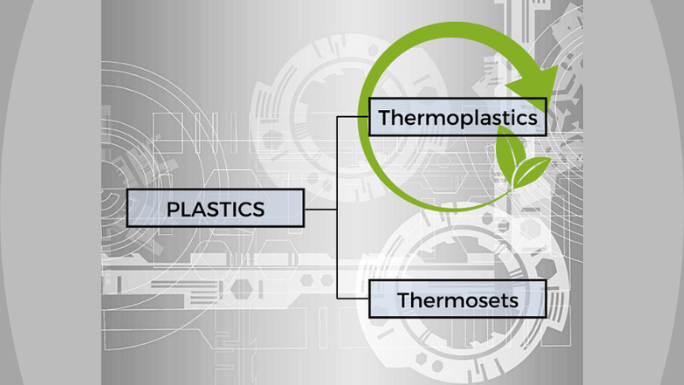
Thermoset vs Thermoplastic - What is the Difference?
Posted by CDI Products on Sep 20, 2021
At a recent meeting with a long-time customer, one of our material scientists was asked a great question: “Can you tell me the difference between thermosets and thermoplastics?”
Although her answer was a bit more complex, the answer really all comes down to one word – heat. While thermosets and thermoplastics are different classes of polymers, what makes them unique is how they react with the introduction of heat.
Let’s look further at thermosets and thermoplastics, discuss their benefits and shortcomings, and highlight the industries where these complex materials make a real impact.
What is a thermoset?
Thermoset plastics are polymeric materials that undergo a permanent change in their molecular structure upon heating, resulting in an irreversible cross-linking reaction. This cross-linking imparts significant improvement in the material's strength, rigidity, and thermal stability, making it an attractive choice for various industrial applications. However, once the thermoset plastic has undergone the initial heat-forming or molding process, it cannot be effectively remolded or reheated, owing to its three-dimensional network structure that prevents any further molecular mobility.
Thermosets
Thermosets, like polyurethane, vulcanized rubber, epoxy, and phenolic, strengthen and are irreversibly hardened when they are heated. During exposure to heat (also known as the curing process), the chemical and physical properties of thermosets permanently change and become “set” in a new solid configuration.
Thermosets are processed at much lower temperatures than other materials, ranging from room temperature to ~300°F. Although thermosets start out as a liquid or soft solid, in their fortified form, thermosets are resistant to deformity and will not melt even when exposed to extremely high temperatures and pressure conditions. This heat-induced stability is just one of the advantages of thermosets.
Advantages of Thermosets
Thermosets offer some significant advantages over other materials, stemming from their post-cure dimensional stability. Because they do not deform or lose their shape, thermosets deliver superior resistance in extreme temperatures conditions, whether hot or cold. They can also handle erratic variations in temperature without failure – the kind often seen in aerospace, automotive, energy, and power generation applications.
After initial heat forming, thermosets provide substantial resistance to many environmental factors beyond temperature. Many thermosets are water-resistant, and they can survive exposure to the elements without warping or losing shape. They are naturally corrosion-resistant too, even in conditions with exposure to inorganic and organic acids.
Thermosets are also a good material selection to prevent mechanical creep (sometimes called cold flow) in conditions of long-term exposure to mechanical stress. With their environmental stability, thermosets are primed for use in medical, marine, geothermal, and defense applications.
Although their strength is a major advantage, thermosets’ light weight and flexibility also make them a great solution for custom-engineered products with strict dimensional specifications. Their combination of durability and high strength-to-weight ratio make them a perfect solution for applications where maximizing efficiency and minimizing energy use are critical. This attribute has made thermosets a trusted material option for the aviation and defense industry for many critical operational systems and major structural components.
Another way that thermosets provide great flexibility is in their flowability, which is the capability of a liquid or particulate solid to move by flow. Thermosets will easily fill every nook and cranny within a mold, which means manufacturers can more easily produce larger parts and more complex geometric shapes right from the mold. Their flowability also means that molding processes can be less complex, often relying on flexible or composite molds, and are therefore more cost-effective.
Strong, resilient, environmentally resistant, flexible, and cost-effective – sounds like thermosets offer some outstanding benefits. There must be a downside, so let’s look at the disadvantages.
Disadvantages of Thermosets
While introduced heat provides thermosets their strength and stability, it also leads to one of their major disadvantages. Thermoset plastics undergo a fundamental chemical change during the curing process that directly impacts their sustainability. Thermoset materials exhibit brittle fracture behavior in case of damage. Thermoset materials have limited shelf or storage life. Usually, thermoset materials require longer processing times compared to other materials.
Once thermosets are heated, they cannot be remolded or reshaped. This means thermosets cannot be easily reused, reclaimed, or recycled. New innovations are opening the door for improved sustainability, with examples like recyclable thermosets called polyhexahydrotriazines (PHTs), which break down in strong acid. However, today most readily available thermosets do not offer a high level of sustainability.
Now let’s take a deeper look at thermoplastics.
Thermoplastics
There are many types and grades of thermoplastics, with varying thermal, chemical, and mechanical properties. Some of the most readily used thermoplastics include PEEK (polyetheretherketone), PEKK (polyetherketoneketone), and PPS (polyphenylene sulfide).
Like thermosets, thermoplastics are physically transformed with the application of heat. Thermoplastics start out as plastic pellets that are evenly heated to transform to a liquid and processed by compression or injection molding and extrusion to the desired shape.
Unlike thermosets, thermoplastics maintain their chemical structure whether they are in a liquid or a solid form. Fundamentally, this means heat can be reintroduced and the thermoplastic can return to its liquid form.
Advantages of Thermoplastics
Because the curing process is 100% reversible, thermoplastics offer a high level of environmental stewardship and sustainability. Manufacturing of thermoplastics creates minimal outgas VOCs and hazardous waste. (Volatile organic compounds, or VOCs, are organic chemicals that have a high vapor pressure at room temperature.)
Thermoplastics can be easily remelted and remolded into new forms, which reduces material waste, improves material supply efficiency, and allows for quality issues to be easily and cost-effectively resolved on the manufacturing floor. Their innate chemical stability means thermoplastics can be used beyond their initial product configuration life cycle.
PEEK or PEKK might be initially used for large structural components that are critical in nature. Once that structural component is no longer of safe use in application, the thermoplastic can be melted down and repurposed for other applications or even other industries.
From an environmental perspective, thermoplastics offer a wealth of benefits. Thermoplastics have an ability to withstand highly corrosive environments and conditions. High-performance thermoplastics are typically flame retardant and can withstand temperatures up to ~500°F.
Thermoplastics show an increased resistance to chemicals, solvents, pollution, radiation, and heat, and they do not disintegrate or lose shape upon exposure. Their chemical stability makes thermoplastics excellent for applications where corrosive fluids of extreme temperatures must flow or be transported. Thermoplastics offer the environmental fortitude needed for critical sealability in pressure-pumping applications, petrochemical plants and refineries, nuclear power generation, and fluid management.
Since thermoplastics maintain their physical and chemical properties at higher temperatures, they also offer enhanced mechanical properties and benefits. High-temperature thermoplastics show an elevated level of resilience, strength, stiffness, resistance to fatigue, and resistance to physical stress (also known as ductility).
Their ability to withstand a high mechanical load means that thermoplastics deliver a longer service life and improve operational and equipment efficiency. Their physical fortitude translates to minimized downtime for many critical applications, including medical devices, automotive, aerospace, telecommunications, environmental monitoring, and many other specialized applications.
Thermoplastics provide strength, but they also offer unique flexibility suited for complex custom applications where regulatory compliance is essential. Thermoplastics can be easily blended with additives to enhance their performance and meet the highest standards of emission, flammability, or biocompatibility. Through blending and compounding, thermoplastics are often ideal for aerospace interior applications, implantable medical devices, pharmaceutical production, and food processing.
Thermoplastic materials have unlimited or long shelf/storage life. Thermoplastic materials have better impact strength compared to thermoset materials. Processing times for thermoplastic materials are usually short and well suited for high-volume production runs.
Environmentally friendly, strong, flexible, and compliant – sounds like thermoplastics are hard to beat. With all things, there is an upside and a downside. Let’s look at some disadvantages associated with thermoplastics.
Disadvantages of Thermoplastics
While introduced heat provides thermoplastics with their flexibility and sustainability, it also leads to one of their major disadvantages. Although there are multiple grades of thermoplastics, they all have a relatively low melting point.
Under extreme heat conditions, thermoplastics soften and can return to their liquid form. Some thermoplastics can even degrade when exposed to direct sunlight or to ultraviolet light for extended periods of time. Although thermoplastics can withstand significant pressures and stress conditions, they can stretch and weaken under long exposure to heat and stress loads (also known as creep susceptibility), or they can even fracture under the right (or better yet wrong) circumstances.
Unlike thermosets, thermoplastics are less cost-effective, as the material prices can be higher and the manufacturing process can be more intensive. Where thermosets can be manufactured using flexible molds, thermoplastics can require a higher grade of tooling and more rigid molds.
Injection molding is one of the most reliable molding options for thermoplastics. Molds for injection molding are highly complex and need to be manufactured to tight tolerances to produce high-quality parts. Due to the high temperature and pressures involved, these molds are machined from metals like hardened steel. Some custom molds can take months to design and complete, which impacts the bottom line.
What does this all mean when it comes to material selection?
Thermosets vs. Thermoplastics
What’s better, a thermoset or a thermoplastic? That’s not the best question to ask. The better question is: Which material is the right option for the application at hand?
Both polymer types deliver significant benefits, but each offers different properties and levels of performance in particular conditions. Understanding the performance strengths and the vulnerabilities of the different thermosets and thermoplastics improves both the material selection and the product design process.
With so many high-performance polymer options available, it can help to talk with a material scientist or an applications engineer to know which material choice is the right one for the job at hand.
CDI’s team of experts has extensive experience with high performance polymer, material selection, applications engineering, custom design, and smart manufacturing. Schedule some time to talk with our team, learn more about thermosets and thermoplastics, and determine which material is right for you.
Topic: engineered thermoplastics, thermoplastics, thermoplastic components, thermosets
